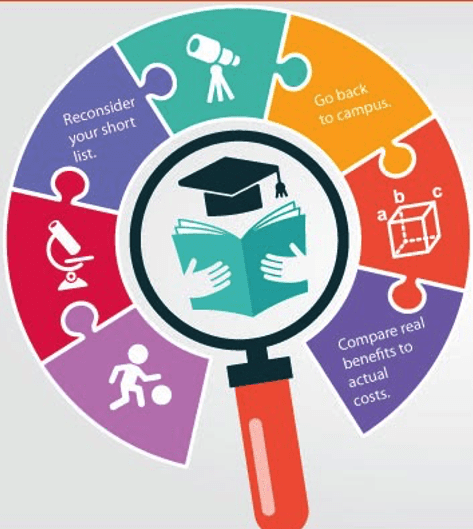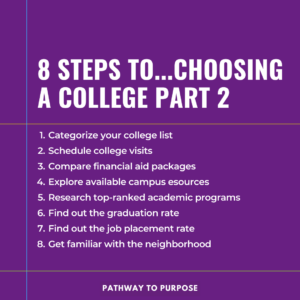With over 4,000 colleges and universities across the nation, choosing a college can be challenging. Before making a selection, consider the type of campus environment you would like. Since college is a unique time to develop academically and personally, choosing the best college is crucial to your success. Check out our 8 Steps to Choosing a College: Part 2!
1. Categorize your college list
After you have learned about the different types of colleges, you can organize your list into categories: top colleges, potential colleges, and safety colleges. Be sure to include the pros and cons of each college as well!
2. Schedule college visits
Picturing yourself as part of the college community is crucial to your success! Getting an up-close look at everything the college has to offer is key to understanding if it is a good fit for you. If you cannot visit in person, be sure to schedule a virtual tour!
3. Compare financial aid packages
Once you are accepted to a college, you will receive an acceptance letter as well as a financial aid award letter from each college. The financial aid award letter will list the types and amount of aid you have been awarded. It is important to understand which aid is free, borrowed or must be earned. Your financial aid award letter for each college will be different. Be sure to carefully review each letter before committing to a college.
4. Explore available campus resources
College and universities offer various campus resources and services such as the: writing center, tutoring, study abroad, and career services. Utilizing campus resources can lead to higher academic achievement and overall satisfaction.
5. Research top-ranked academic programs
Top-ranked programs result in better career opportunities, job security, and satisfaction. Your salary potential will vary based on your major and intended career.
6. Find out the graduation rate
The graduation rate indicates the rate at which students finish their degree within the expected time. It can also help you determine the quality of a college, since higher graduation rates may indicate the quality of student support services and resources.
7. Find out the job placement rate
Job placement rate indicates the percentage of students that are employed after graduating from college. This information is available for each college. Finding out the job placement rate can help you determine the likelihood of being employed after graduation.
8. Get familiar with the neighborhood
College will be your home for two or four years. Do you want to attend a college that is located in or near a big city? Or would you prefer a rural college? Be sure to also check out the local restaurants, shopping malls, parks, and tourist attractions. Finding a place where you can learn, work, eat, and play—a place where you feel comfortable as a member of a community is crucial to your academic success.



